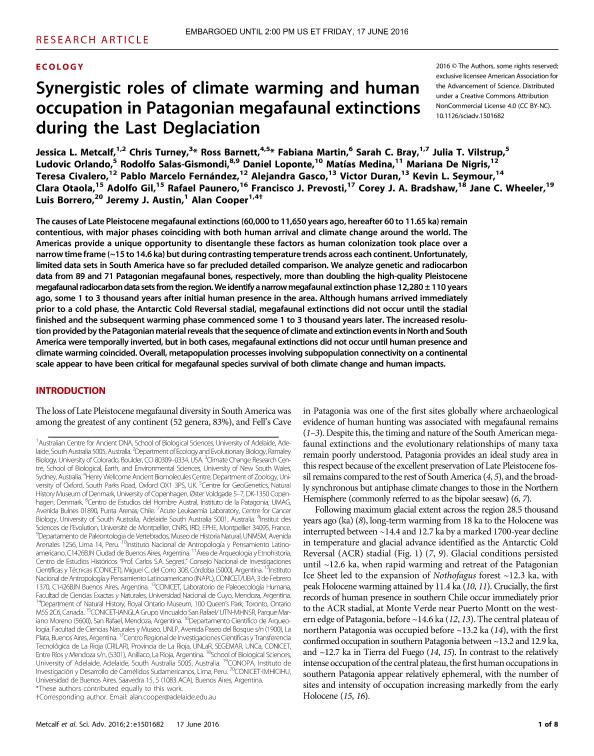Artículo
Synergistic roles of climate warming and human occupation in Patagonian megafaunal extinctions during the Last Deglaciation
Metcalf, Jessica L.; Turney, Chris; Barnett, Ross; Martin, Fabiana; Bray, Sarah C.; Vilstrup, Julia T.; Orlando, Ludovic; Salas-Gismondi, Rodolfo; Loponte, Daniel Marcelo ; Medina, Matias Eduardo
; Medina, Matias Eduardo ; de Nigris, Mariana Eleonor
; de Nigris, Mariana Eleonor ; Civalero, Maria Teresa
; Civalero, Maria Teresa ; Fernández, Pablo Marcelo
; Fernández, Pablo Marcelo ; Gasco, Alejandra Valeria
; Gasco, Alejandra Valeria ; Duran, Victor Alberto
; Duran, Victor Alberto ; Seymour, Kevin L.; Otaola, Clara
; Seymour, Kevin L.; Otaola, Clara ; Gil, Adolfo Fabian
; Gil, Adolfo Fabian ; Paunero, Rafael; Prevosti, Francisco Juan
; Paunero, Rafael; Prevosti, Francisco Juan ; Bradshaw, Corey J. A.; Wheeler, Jane C.; Borrero, Luis Alberto
; Bradshaw, Corey J. A.; Wheeler, Jane C.; Borrero, Luis Alberto ; Austin, Jeremy J.; Cooper, Alan
; Austin, Jeremy J.; Cooper, Alan
 ; Medina, Matias Eduardo
; Medina, Matias Eduardo ; de Nigris, Mariana Eleonor
; de Nigris, Mariana Eleonor ; Civalero, Maria Teresa
; Civalero, Maria Teresa ; Fernández, Pablo Marcelo
; Fernández, Pablo Marcelo ; Gasco, Alejandra Valeria
; Gasco, Alejandra Valeria ; Duran, Victor Alberto
; Duran, Victor Alberto ; Seymour, Kevin L.; Otaola, Clara
; Seymour, Kevin L.; Otaola, Clara ; Gil, Adolfo Fabian
; Gil, Adolfo Fabian ; Paunero, Rafael; Prevosti, Francisco Juan
; Paunero, Rafael; Prevosti, Francisco Juan ; Bradshaw, Corey J. A.; Wheeler, Jane C.; Borrero, Luis Alberto
; Bradshaw, Corey J. A.; Wheeler, Jane C.; Borrero, Luis Alberto ; Austin, Jeremy J.; Cooper, Alan
; Austin, Jeremy J.; Cooper, Alan
Fecha de publicación:
06/2016
Editorial:
Science
Revista:
Science Advances
ISSN:
2375-2548
Idioma:
Inglés
Tipo de recurso:
Artículo publicado
Clasificación temática:
Resumen
The causes of Late Pleistocene megafaunal extinctions (60,000 to 11,650 years ago, hereafter 60 to 11.65 ka) remain contentious, with major phases coinciding with both human arrival and climate change around the world. The Americas provide a unique opportunity to disentangle these factors as human colonization took place over a narrow time frame (~15 to 14.6 ka) but during contrasting temperature trends across each continent. Unfortunately, limited data sets in South America have so far precluded detailed comparison. We analyze genetic and radiocarbon data from 89 and 71 Patagonian megafaunal bones, respectively, more than doubling the high-quality Pleistocene megafaunal radiocarbon data sets from the region.We identify a narrowmegafaunal extinction phase 12,280 ± 110 years ago, some 1 to 3 thousand years after initial human presence in the area. Although humans arrived immediately prior to a cold phase, the Antarctic Cold Reversal stadial, megafaunal extinctions did not occur until the stadial finished and the subsequent warming phase commenced some 1 to 3 thousand years later. The increased resolution provided by the Patagonian material reveals that the sequence of climate and extinction events in North and South America were temporally inverted, but in both cases, megafaunal extinctions did not occur until human presence and climate warming coincided. Overall, metapopulation processes involving subpopulation connectivity on a continental scale appear to have been critical for megafaunal species survival of both climate change and human impacts.
Palabras clave:
Climate
,
Hunting
,
Megafaunal
,
Extinction
,
Patagonia
Archivos asociados
Licencia
Identificadores
Colecciones
Articulos(CCT - MENDOZA)
Articulos de CTRO.CIENTIFICO TECNOL.CONICET - MENDOZA
Articulos de CTRO.CIENTIFICO TECNOL.CONICET - MENDOZA
Articulos(CRILAR)
Articulos de CENTRO REGIONAL DE INV. CIENTIFICAS Y TRANSFERENCIA TECNOLOGICA DE ANILLACO
Articulos de CENTRO REGIONAL DE INV. CIENTIFICAS Y TRANSFERENCIA TECNOLOGICA DE ANILLACO
Articulos(IMHICIHU)
Articulos de INST.MULTIDISCIP.DE HISTORIA Y CS.HUMANAS
Articulos de INST.MULTIDISCIP.DE HISTORIA Y CS.HUMANAS
Citación
Metcalf, Jessica L.; Turney, Chris; Barnett, Ross; Martin, Fabiana; Bray, Sarah C.; et al.; Synergistic roles of climate warming and human occupation in Patagonian megafaunal extinctions during the Last Deglaciation; Science; Science Advances; 2; 6-2016; 1-8
Compartir
Altmétricas



